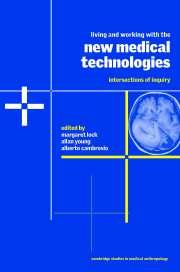Book contents
- Frontmatter
- Contents
- List of contributors
- 1 Introduction
- Part I Epochal transitions? Biomedicine and the transformation of socionature
- Part II Laboratories and clinics: the material cultures of biomedicine
- Part III Technologies and bodies: the extended networks of biomedicine
- 8 Screening the body: the pap smear and the mammogram
- 9 Extra chromosomes and blue tulips: medico-familial interpretations
- 10 When explanations rest: “good-enough” brain science and the new socio-medical disorders
- 11 On dying twice: culture, technology and the determination of death
- 12 The practice of organ transplants: networks, documents, translations
- Index
9 - Extra chromosomes and blue tulips: medico-familial interpretations
Published online by Cambridge University Press: 23 December 2009
- Frontmatter
- Contents
- List of contributors
- 1 Introduction
- Part I Epochal transitions? Biomedicine and the transformation of socionature
- Part II Laboratories and clinics: the material cultures of biomedicine
- Part III Technologies and bodies: the extended networks of biomedicine
- 8 Screening the body: the pap smear and the mammogram
- 9 Extra chromosomes and blue tulips: medico-familial interpretations
- 10 When explanations rest: “good-enough” brain science and the new socio-medical disorders
- 11 On dying twice: culture, technology and the determination of death
- 12 The practice of organ transplants: networks, documents, translations
- Index
Summary
So they diagnosed Amelia right away, on the delivery table, she was barely out, I barely got a chance to catch my breath or marvel at my first baby when this doctor pours this bad news all over us. “She's got Down syndrome,” he says to us, very coldly. And after he tells us about blood tests and confirmations and all this stuff, we say to him, “But what does that mean? What should we expect?” And just as coldly he says, “Don't expect much. Maybe she'll grow up to be an elevator operator. Don't expect much.” So we clung to each other, and cried.
(April Schwartz, white lawyer, mother of a four-year-old with Down syndrome)My doctor was so angry with me, he couldn't believe I didn't take that test, “How could you let this happen?,” he yelled at me, “you're 40!” But I think something else: Even though he's mentally retarded, he could be a good person.‥ It's just like finding out you have a new job. You just do it, and you accept it, that's all there is to it.
(Anna Morante, Puerto Rican nurse's aide, mother of a seven-year-old with Down syndrome)In humans, the twenty-first chromosome suffers nondisjunction at a remarkably high frequency, with unfortunately rather tragic effect.‥ These unfortunate children suffer mild to severe mental retardation and have a reduced life expectancy.‥ We have no clue as to why an extra twenty-first chromosome should yield the highly specific set of abnormalities associated with trisomy-21. But at least it can be identified in utero by counting the chromosomes in fetal cells, providing an option for early abortion.
(Gould 1980)- Type
- Chapter
- Information
- Living and Working with the New Medical TechnologiesIntersections of Inquiry, pp. 184 - 208Publisher: Cambridge University PressPrint publication year: 2000
- 14
- Cited by



